Superman/Batman: Supergirl Grade: A
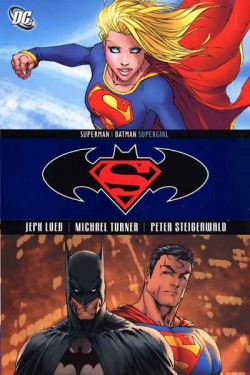
The introduction of Supergirl by Jeph Loeb and Michael Turner was damn near perfect. The art was fantastic-- some of the best work ever done on a Supergirl book. The coloring was wonderful too. This storyline in Superman/Batman also gave Supergirl her richest, most detailed, and by far most interesting origin. Most importantly, the characterization of Supergirl was never better. Supergirl was no longer the blond airhead. She was no longer the one dimensional, giggles and tears girl who was given puerile and, quite frankly, sexist storylines.
Supergirl now was a fully realized and independant character. She was intelligent and tough. She learned multiple languages, trained with the Amazons, and seemed stronger and faster than Superman. No longer did the idea that Supergirl was female and young seem like a handicap. This character taught young girls that a Supergirl was every bit as good as a Superman (and far more interesting). The comic buying public seemed to agree. Excitement over Supergirl was never as high as it was after this spectacular introduction to the character. Based on this wonderful origin, Supergirl's own title opened with record sales that far exceeded anyone's wildest dreams for the character.
Supergirl now was a fully realized and independant character. She was intelligent and tough. She learned multiple languages, trained with the Amazons, and seemed stronger and faster than Superman. No longer did the idea that Supergirl was female and young seem like a handicap. This character taught young girls that a Supergirl was every bit as good as a Superman (and far more interesting). The comic buying public seemed to agree. Excitement over Supergirl was never as high as it was after this spectacular introduction to the character. Based on this wonderful origin, Supergirl's own title opened with record sales that far exceeded anyone's wildest dreams for the character.
Supergirl: Power Grade: A-
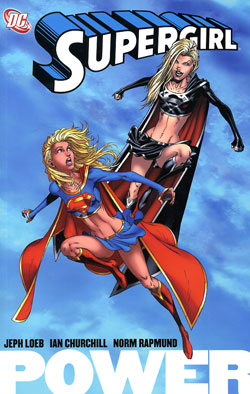
Supergirl: Power collects issues #0 -5 of Supergirl's current series. Loeb continues the writing duties after his fantastic Superman/Batman:Supergirl. Ian Churchill takes over as the regular artist.
First off, Ian Churchill lived up to the incredibly high standards set by Michael Turner. The artwork in the book was generally considered among (if not the) best DC had to offer. Churchill's Supergirl remains one of my favorites.
As far as the writing goes, there is a slight dip in the overall qaulity compared to Superman/Batman: Supergirl, but this is still a very good collection. Supergirl remains an increibly strong and incredibly fun character who takes a backseat to nobody. What I liked most about Loeb's Supergirl is that one of her few weaknesses, besides kryptonite, seems to be that she is overconfident and headstrong. This ultimately caused her to lose a battle to Lex Luthor. How refreshing it seemed to have a Supergirl with power levels this great and who is confident, headstrong, and opinionated. The exact opposite of the old-fashioned 1950's Supergirl who was victimized by the era's sexist ideas of what a teenage girl should be.
There are two reasons for the giving this collection an A- instead of an A. First, Loeb wanted this arc to be a "whirlwind tour of the DCU." Loeb loves guest stars and super hero fights and this collection, unfortunately, has too many of them. I appreciate that Loeb clearly made Power Girl and Superboy the "bad guys" in the fight, but I would've prefered more Suergirl vs. real bad guy. The other problem was this was when DC started allowing Supergirl haters to call the shots. Superman punching Supergirl and sayin "Don't believe everything you hear" in reaction to Supergirl mentioning her greater powers was clearly to appease the "Superman must be the Alpha Male" crowd.
First off, Ian Churchill lived up to the incredibly high standards set by Michael Turner. The artwork in the book was generally considered among (if not the) best DC had to offer. Churchill's Supergirl remains one of my favorites.
As far as the writing goes, there is a slight dip in the overall qaulity compared to Superman/Batman: Supergirl, but this is still a very good collection. Supergirl remains an increibly strong and incredibly fun character who takes a backseat to nobody. What I liked most about Loeb's Supergirl is that one of her few weaknesses, besides kryptonite, seems to be that she is overconfident and headstrong. This ultimately caused her to lose a battle to Lex Luthor. How refreshing it seemed to have a Supergirl with power levels this great and who is confident, headstrong, and opinionated. The exact opposite of the old-fashioned 1950's Supergirl who was victimized by the era's sexist ideas of what a teenage girl should be.
There are two reasons for the giving this collection an A- instead of an A. First, Loeb wanted this arc to be a "whirlwind tour of the DCU." Loeb loves guest stars and super hero fights and this collection, unfortunately, has too many of them. I appreciate that Loeb clearly made Power Girl and Superboy the "bad guys" in the fight, but I would've prefered more Suergirl vs. real bad guy. The other problem was this was when DC started allowing Supergirl haters to call the shots. Superman punching Supergirl and sayin "Don't believe everything you hear" in reaction to Supergirl mentioning her greater powers was clearly to appease the "Superman must be the Alpha Male" crowd.
Supergirl: Candor Grade: C
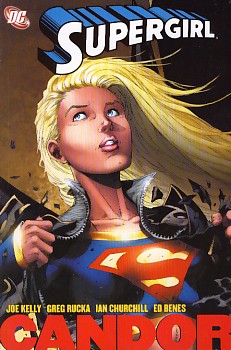
Supergirl: Candor collects Supergirl issues #6-9 as well as some Guest appearances. Joe Kelly takes over as the regular writer and Greg Rucka does the plotting as well as some writing in the earlier issues of this collection. Ian Churchill continues his fantastic run as the series' regular artist.
Churchill's artwork and his Supergirl are among the best. There is nothing at all to complain about regarding the artwork in this collection. Supergirl continued to be one of DC's best books visually.
With this collection, Supergirl began to hit an "up and down" stretch until the book went downhill alltogether beginning with issue #19. In Kelly and Rucka's Candor, the writing team fails to make Supergirl as fun, exciting, and likeable as Loeb did. Instead of outspoken, powerful, headstrong, and over confident, the Supergirl in Candor sometimes came off as rude and selfish. This arc ultimately ends with Supergirl making a teribble decision regarding the people of Candor. The book again suffers from attempting to please Supergirl haters as well. This time, Supergirl is made the bad guy and Power Girl is made to be the good guy in order to please the Power Girl fanbase-- a fanbase that has always been very rude to and jealous of Supergirl fans. Still, the bad mixed with the good and the art continued to be fantastic.
Churchill's artwork and his Supergirl are among the best. There is nothing at all to complain about regarding the artwork in this collection. Supergirl continued to be one of DC's best books visually.
With this collection, Supergirl began to hit an "up and down" stretch until the book went downhill alltogether beginning with issue #19. In Kelly and Rucka's Candor, the writing team fails to make Supergirl as fun, exciting, and likeable as Loeb did. Instead of outspoken, powerful, headstrong, and over confident, the Supergirl in Candor sometimes came off as rude and selfish. This arc ultimately ends with Supergirl making a teribble decision regarding the people of Candor. The book again suffers from attempting to please Supergirl haters as well. This time, Supergirl is made the bad guy and Power Girl is made to be the good guy in order to please the Power Girl fanbase-- a fanbase that has always been very rude to and jealous of Supergirl fans. Still, the bad mixed with the good and the art continued to be fantastic.
Supergirl #10 Grade: A Supergirl #11 Grade: B
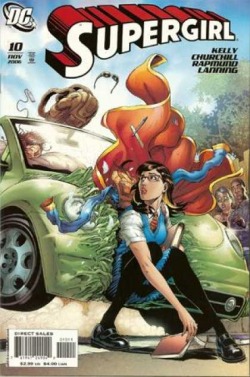
Supergirl #10 was a fun and very well done issue. This one was among Kelly's best and among the best single issues the series has had to date. In this issue, Supergirl makes an attempt at having a secret identity. This, of course, does not work out to well for her. Here, Supergirl deals with the tough realities of being a young girl, going to school, and fitting in. After Supergirl witnesses bullying and some of the worst behavior that happens in schools, she finally can't keep it in. She reveals herself to be Supergirl and gives the girls a firm tongue lashing. A great issue from beginning to end.
Supergirl #11 did not live up to the high standards of issue #10, but was still a good issue. Joe Benitez fills in for Churchill and does a very admirable job. Also, Supergirl feels like a teen girl in this issue. I honestly miss when she had teenage hormones and developed crushes. This hasn't been the case at all since issue #18, so, if you are buying trades and reading the series beginning to end, enjoy it while you can. The overall plotline is a bit confusing and this issue is not without its problems, but, all in all, a good issue and a very likeable Supergirl.
Supergirl #11 did not live up to the high standards of issue #10, but was still a good issue. Joe Benitez fills in for Churchill and does a very admirable job. Also, Supergirl feels like a teen girl in this issue. I honestly miss when she had teenage hormones and developed crushes. This hasn't been the case at all since issue #18, so, if you are buying trades and reading the series beginning to end, enjoy it while you can. The overall plotline is a bit confusing and this issue is not without its problems, but, all in all, a good issue and a very likeable Supergirl.
Supergirl #12 Grade: F
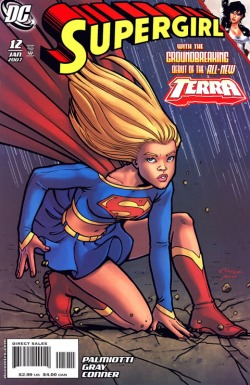
Jimmy Palmiotti Writes, Amanda Conner does the art.
This issue could be the worst issue in Supergirl history. Honestly, I have no idea what the Supergirl editorial group was thinking to allow Supergirl to be written this way. Quite frankly, this issue seems like it was written to insult Supergirl and her fans in order to make Terra look good. As a matter of fact, this issue is the one issue where Supergirl actually does seem like "Britney" Zor El, as Supergirl haters were calling her. In this issue, she grinds with a guy at a dance club. When people's lives are in danger, she exclaims, in typical bimbo fashion, "I'd rather be dancing." As she continues to show herself to be a complete airhead throughout this issue, Terra insults her to her face and lets her know she isn't much of a Supergirl. Supergirl then doesn't speak up for herself, but sits on a couch and pouts. This was the first time I read an issue of Supergirl where I hated my favorite character. Unfortunately,it wouldn't be the last. Palmiotti has continued to be terrible to Supergirl since this issue. He wrote a miniseries that saw Supergirl get her butt kicked easily and then cry about it while Superman easily overpowers the same bad girl with one arm. His Wednesday Comics continues to portray her as an emotional, dumb blonde who plays with puppies and kitties. At its best, Palmiotti's Supergirl sucks. At its worst, his Supergirl is sexist and offensive. How is this piece of crap supposed to be empowering to young females?
This issue could be the worst issue in Supergirl history. Honestly, I have no idea what the Supergirl editorial group was thinking to allow Supergirl to be written this way. Quite frankly, this issue seems like it was written to insult Supergirl and her fans in order to make Terra look good. As a matter of fact, this issue is the one issue where Supergirl actually does seem like "Britney" Zor El, as Supergirl haters were calling her. In this issue, she grinds with a guy at a dance club. When people's lives are in danger, she exclaims, in typical bimbo fashion, "I'd rather be dancing." As she continues to show herself to be a complete airhead throughout this issue, Terra insults her to her face and lets her know she isn't much of a Supergirl. Supergirl then doesn't speak up for herself, but sits on a couch and pouts. This was the first time I read an issue of Supergirl where I hated my favorite character. Unfortunately,it wouldn't be the last. Palmiotti has continued to be terrible to Supergirl since this issue. He wrote a miniseries that saw Supergirl get her butt kicked easily and then cry about it while Superman easily overpowers the same bad girl with one arm. His Wednesday Comics continues to portray her as an emotional, dumb blonde who plays with puppies and kitties. At its best, Palmiotti's Supergirl sucks. At its worst, his Supergirl is sexist and offensive. How is this piece of crap supposed to be empowering to young females?
Supergirl #13-18 Grade: A-
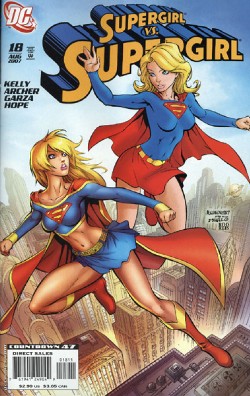
Joe Kelly writes and Churchill and Garza do most of the art.
The art in the Churchill issues is spectacular as always. When Garza joins, the art style changes but is still good. Honestly, the Garza Supergirl was the best compromise between the constantly bickering factions. The art suffers quite a bit, though, when some issues are a mix of Garza and another artist trying to match his style.
The writing, when at its best, is equal to Loeb's best issues. There also really isn't a bad issue among these issues either. I don't know that I was ever actually a fan of Supergirl developing a power where she shoots crystals out of her body when in danger (I think she should have flash fried Batgirl in 2 seconds instead), but the writing was still good. The highlights among these issues are the Power Boy storyline, where we discover that Power Boy is an obsessive and abusive boyfriend and Supergirl promptly teaches him a lesson, and issue 18. Issue 18 suffers from the mixing and matching of two different artists, but the Supergirl that was written here is one that I love above all others. She is being attacked by a villainess disguised as a version of Supergirl. This villainess has been attempting to drive Supergirl mad. She had attempted to assassinate Supergirl, had attempted to make Supergirl kill Superman, and she has attempted to destroy Supergirl mentally. Supergirl, however, overcomes all of these challenges with flying colors. She defeats the villainess and proves she is very much worthy of the title Supergirl. And the way Supergirl defines herself as she is kicking the bad girl's butt... wow! That is the Supergirl I want to read. Now that is a Supergirl that is fun, empowering, and not simplistic. This is who Supergirl should still be.
The art in the Churchill issues is spectacular as always. When Garza joins, the art style changes but is still good. Honestly, the Garza Supergirl was the best compromise between the constantly bickering factions. The art suffers quite a bit, though, when some issues are a mix of Garza and another artist trying to match his style.
The writing, when at its best, is equal to Loeb's best issues. There also really isn't a bad issue among these issues either. I don't know that I was ever actually a fan of Supergirl developing a power where she shoots crystals out of her body when in danger (I think she should have flash fried Batgirl in 2 seconds instead), but the writing was still good. The highlights among these issues are the Power Boy storyline, where we discover that Power Boy is an obsessive and abusive boyfriend and Supergirl promptly teaches him a lesson, and issue 18. Issue 18 suffers from the mixing and matching of two different artists, but the Supergirl that was written here is one that I love above all others. She is being attacked by a villainess disguised as a version of Supergirl. This villainess has been attempting to drive Supergirl mad. She had attempted to assassinate Supergirl, had attempted to make Supergirl kill Superman, and she has attempted to destroy Supergirl mentally. Supergirl, however, overcomes all of these challenges with flying colors. She defeats the villainess and proves she is very much worthy of the title Supergirl. And the way Supergirl defines herself as she is kicking the bad girl's butt... wow! That is the Supergirl I want to read. Now that is a Supergirl that is fun, empowering, and not simplistic. This is who Supergirl should still be.
Supergirl #19 Grade: D-
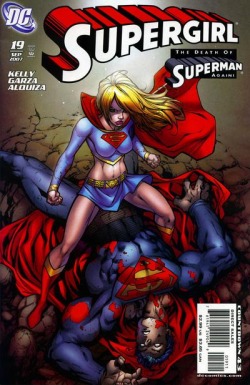
Joe Kelly Writes, Garza does the art.
Garza's art in the issue was fine. Again, it was a much better compromise than what comes next.
There isn't too much to say about this issue. It is easily Kelly's worst. I get the feeling Matt Idelson, wimping out after being called names by the puritans, forced Kelly to write this version of Supergirl. In this issue, she doesn't seem to have much of a personality. After the great issue #18 with her wonderful speech describing what she was all about, this issue was a complete let down. Supergirl smiles and giggles and apologizes to everyone for existing. She even apologizes to Power Girl. Where is Power Girl's apology to Supergirl?
To speak frankly, this issue and this Supergirl sucks. She has continued to suck in almost every issue she has appeared in after this as well. Only the horrors of Puckett and Palmiotti save this issue from an F. Nothing is as bad as Supergirl by Puckett or Palmiotti.
Garza's art in the issue was fine. Again, it was a much better compromise than what comes next.
There isn't too much to say about this issue. It is easily Kelly's worst. I get the feeling Matt Idelson, wimping out after being called names by the puritans, forced Kelly to write this version of Supergirl. In this issue, she doesn't seem to have much of a personality. After the great issue #18 with her wonderful speech describing what she was all about, this issue was a complete let down. Supergirl smiles and giggles and apologizes to everyone for existing. She even apologizes to Power Girl. Where is Power Girl's apology to Supergirl?
To speak frankly, this issue and this Supergirl sucks. She has continued to suck in almost every issue she has appeared in after this as well. Only the horrors of Puckett and Palmiotti save this issue from an F. Nothing is as bad as Supergirl by Puckett or Palmiotti.
Supergirl #20 -22 Grade: D-
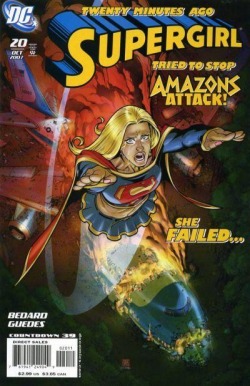
Tony Bedard writes, Renato Guedes does the art.
This is where we see Matt Idelson turn complete wimp, sell out the fans that defended him and the Supergirl teams, and make Supergirl tailor made for the puritans.
Guedes can draw, but his Supergirl was the worst. Fat, stubby legs. A suit that was ten times too big for her. And the first appearance of those disgusting, giant undershorts that continue to make Supergirl look like a bland prude. Considering how all the other characters in the DC universe dress, it is easy to see that they became very hypocritical with Supergirl. Supergirl was sacrificed in order to shut up the puritans. The odd thing is, Supergirl was one of the few who actually did sex appeal the right way. She wasn't almost naked, she doesn't have huge boobs and her cleavage hanging out. Yet this is the character who became censored. Comic books are a fantasy genre. I am not going to spend my money on a character whom I would have no interest in looking at in reality. Why don't they give this treatment to Superboy or Power Girl?
The writing sucked too. Supergirl fails and Supergirl crying on the cover is all you need to know. Bedard's Supergirl isn't very effective and she needs a man to tell her how to battle the Amazons. Yup, he should know better than her, she only lived and trained with them. Bedard, like Puckett, Palmiotti, Guedes, Idelson and Igle, is one of those people that should never be around Supergirl. In Supergirl and the Legion of Superheroes and in R.E.B.E.L.S. he continued to write Supergirl as an unlikeable bumpkin who, I don't believe, ever fought anything well (perhaps never even landed a punch). His Supergirl is also always dumb enough to be used by green skinned males. Not a very empowering or satisfying Supergirl.
This is where we see Matt Idelson turn complete wimp, sell out the fans that defended him and the Supergirl teams, and make Supergirl tailor made for the puritans.
Guedes can draw, but his Supergirl was the worst. Fat, stubby legs. A suit that was ten times too big for her. And the first appearance of those disgusting, giant undershorts that continue to make Supergirl look like a bland prude. Considering how all the other characters in the DC universe dress, it is easy to see that they became very hypocritical with Supergirl. Supergirl was sacrificed in order to shut up the puritans. The odd thing is, Supergirl was one of the few who actually did sex appeal the right way. She wasn't almost naked, she doesn't have huge boobs and her cleavage hanging out. Yet this is the character who became censored. Comic books are a fantasy genre. I am not going to spend my money on a character whom I would have no interest in looking at in reality. Why don't they give this treatment to Superboy or Power Girl?
The writing sucked too. Supergirl fails and Supergirl crying on the cover is all you need to know. Bedard's Supergirl isn't very effective and she needs a man to tell her how to battle the Amazons. Yup, he should know better than her, she only lived and trained with them. Bedard, like Puckett, Palmiotti, Guedes, Idelson and Igle, is one of those people that should never be around Supergirl. In Supergirl and the Legion of Superheroes and in R.E.B.E.L.S. he continued to write Supergirl as an unlikeable bumpkin who, I don't believe, ever fought anything well (perhaps never even landed a punch). His Supergirl is also always dumb enough to be used by green skinned males. Not a very empowering or satisfying Supergirl.
Supergirl #23-32 Grade: F
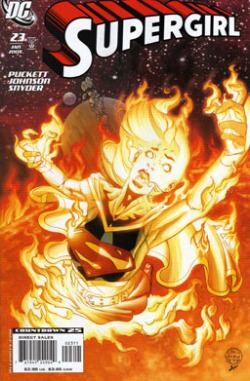
Writer (and Supergirl hater) Kelley Puckett, Art by Drew Johnson
As you can see, the worst regular writer in Supergirl history had the book far too long.
The art wasn't as bad as what was before, nor as bad as what was to come. When the unpopularity and divisiveness of the undershorts was revealed, Johnson chose the Leonard Kirk rmethod: just don't show what's under the skirt. Much better than undershorts, although, considering most heroines wear brief cut bottoms without a cape or skirt to cover, what Supergirl wore under the skirt all the way up through issue 19 of the current series shouldn't be a problem.
The writing, however, was awful. This felt like ten issues of insults aimed at Supergirl, Supergirl fans, blondes, women, teenage girls, etc. His Supergirl failed at every single thing she tried. She broke people's arms while attempting to save them. Average citizens considered her Superman's inferior and insulted her. She couldn't save people from burning buildings, couldn't fight bad guys, and did more harm than good whenever she attempted anything. Her dialogue always made her sound like a ditz. Wonder Woman told her she needed to be on a shorter leash. And, Superman had to fly down and fix all of her mistakes. She cried. She never spoke up for herself. When insulted, she looked at her feet and said "I'm sorry." The message of this series seemed to be that a Supergirl isn't good enough or smart enough, you need a man to do the job. Everyone from Idelson on down should be kicked off of Supergirl forever for letting this mess happen. Do not, I repeat, DO NOT LET YOUR DAUGHTERS READ PUCKETT"S SUPERGIRL. There is nowheres near adequate space to describe how truely insulting Puckett's run was to females and Supergirl fans alike.
As you can see, the worst regular writer in Supergirl history had the book far too long.
The art wasn't as bad as what was before, nor as bad as what was to come. When the unpopularity and divisiveness of the undershorts was revealed, Johnson chose the Leonard Kirk rmethod: just don't show what's under the skirt. Much better than undershorts, although, considering most heroines wear brief cut bottoms without a cape or skirt to cover, what Supergirl wore under the skirt all the way up through issue 19 of the current series shouldn't be a problem.
The writing, however, was awful. This felt like ten issues of insults aimed at Supergirl, Supergirl fans, blondes, women, teenage girls, etc. His Supergirl failed at every single thing she tried. She broke people's arms while attempting to save them. Average citizens considered her Superman's inferior and insulted her. She couldn't save people from burning buildings, couldn't fight bad guys, and did more harm than good whenever she attempted anything. Her dialogue always made her sound like a ditz. Wonder Woman told her she needed to be on a shorter leash. And, Superman had to fly down and fix all of her mistakes. She cried. She never spoke up for herself. When insulted, she looked at her feet and said "I'm sorry." The message of this series seemed to be that a Supergirl isn't good enough or smart enough, you need a man to do the job. Everyone from Idelson on down should be kicked off of Supergirl forever for letting this mess happen. Do not, I repeat, DO NOT LET YOUR DAUGHTERS READ PUCKETT"S SUPERGIRL. There is nowheres near adequate space to describe how truely insulting Puckett's run was to females and Supergirl fans alike.
Supergirl #33 Grade: A

James Peaty writes, Ron Randall does the art.
What is this? Somewhere in the middle of the terrible mess that is Supergirl #19- present there is an issue I would give an "A" to.
Ron Randall's Supergirl is, perhap, the best that has been inside the pages of Supergirl since Churchill left. I don't remember those ugly undershorts showing at any time. His Supergirl was fun, had the right amount of sex appeal, and was well drawn.
James Peaty, for one issue, was a godsend to fans who hated everying that Supergirl 19 and beyond was about. In this issue, Supergirl's power levels were respected. She defeated the bad guy by using her brain. She was back to being spirited, opinionated, and headstrong. Best of all, she was clearly not Superman in a skirt. This Supergirl kicked butt and was exactly the way I would want to see her portrayed on a regular basis.
What DC should have done was get rid of the undershorts, give the book over to Peaty. Have Randall (or Lee, Benes, Frank, Churchill, Land etc.) do the art. The constant fighting would have stopped. The many Supergirl fans who dropped the book because of Idelson's idiotic changes might have come back. Instead, this is the one bright spot amongst a whole mess of bad Supergirl issues.
What is this? Somewhere in the middle of the terrible mess that is Supergirl #19- present there is an issue I would give an "A" to.
Ron Randall's Supergirl is, perhap, the best that has been inside the pages of Supergirl since Churchill left. I don't remember those ugly undershorts showing at any time. His Supergirl was fun, had the right amount of sex appeal, and was well drawn.
James Peaty, for one issue, was a godsend to fans who hated everying that Supergirl 19 and beyond was about. In this issue, Supergirl's power levels were respected. She defeated the bad guy by using her brain. She was back to being spirited, opinionated, and headstrong. Best of all, she was clearly not Superman in a skirt. This Supergirl kicked butt and was exactly the way I would want to see her portrayed on a regular basis.
What DC should have done was get rid of the undershorts, give the book over to Peaty. Have Randall (or Lee, Benes, Frank, Churchill, Land etc.) do the art. The constant fighting would have stopped. The many Supergirl fans who dropped the book because of Idelson's idiotic changes might have come back. Instead, this is the one bright spot amongst a whole mess of bad Supergirl issues.
Supergirl #34 - Present Grade: D+
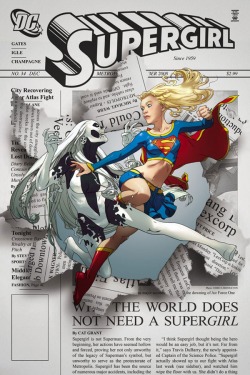
Sterling Gates writes, Jamal Igle does the art.
Jamal Igle and Matt Idelson are two of the biggest things wrong with this book. An artist who uses sexist epithets to describe an outfit no more revealing than a cheeleader's should not be drawing Supergirl. Whenever Jamal opens his mouth on the the subject of the undershorts, he sticks his foot in it. Whenever he (or anyone else) attempts to explain the reasoning, there are a million holes, double standards, and hypocricies. Either apply your logic to every character-- male and female-- or do away with those damned under shorts.
Idelson is just as bad. Igle threw him under the bus to try and deflect the anger many Supergirl fans felt at the ugly undershorts and the restrictions facing Supergirl's dress and personality by identifying him as the culprit who said "I never want to see Supergirl's panties again."
Idelson clearly just wimped out. He couldn't take being insulted by the puritans. Get someone with some balls on this book who won't betray loyal fans and let people who make blog posts stating "I hate Supergirl" dictate how the character is presented.
Gates has good points and bad. He doesn't write Supergirl in an offensive manner, like Palmiotti and Puckett. He also has done a good job creating strong villains for her to face. The problem is, at least through issue 36 when I officially dropped this series (I will return when the undershorts go and more concessions to the fans of 1-18 are made) his Supergirl is boring. She lacks personality, spirit, fire. She just doesn't seem worth looking at or reading about anymore. The other problem is Supergirl's parents being brought back to life, the idiotic "kryptonite poisoning" explain all, and other things that he has done to ruin her origin. It is kind of like DC is telling all fans of Loeb and Kelly's Supergirl "get lost! You bought those books and defended the character from haters for nothing." Now, sales are slipping into the 20,000's. Newsarama, NPR, and elsewhere have featured stories on the anger and fighting created by the undershorts. Clearly things are not working out for Idelson and DC with this title. Supergirl is the least interesting character in her own series, DC is trying to compensate for the mass loss of Supergirl fans since issue #20 by constantly tying Supergirl into crossovers. Get rid of the undershorts. Go to the classic movie version of the costume (both sides agreed on it and it makes so much sense). Switch creative teams. Allow Supergirl to be spirited and outspoken again. If you are creating Supergirl for those message board posters who think girls that speak up are "bitches" and that girls who dress in something no more revealing than a cheerleading uniform "are asking to be raped," you are really going crazy. The most disgusting sexist posts have been made by people on that side of the argument. Quit catering to them.
Jamal Igle and Matt Idelson are two of the biggest things wrong with this book. An artist who uses sexist epithets to describe an outfit no more revealing than a cheeleader's should not be drawing Supergirl. Whenever Jamal opens his mouth on the the subject of the undershorts, he sticks his foot in it. Whenever he (or anyone else) attempts to explain the reasoning, there are a million holes, double standards, and hypocricies. Either apply your logic to every character-- male and female-- or do away with those damned under shorts.
Idelson is just as bad. Igle threw him under the bus to try and deflect the anger many Supergirl fans felt at the ugly undershorts and the restrictions facing Supergirl's dress and personality by identifying him as the culprit who said "I never want to see Supergirl's panties again."
Idelson clearly just wimped out. He couldn't take being insulted by the puritans. Get someone with some balls on this book who won't betray loyal fans and let people who make blog posts stating "I hate Supergirl" dictate how the character is presented.
Gates has good points and bad. He doesn't write Supergirl in an offensive manner, like Palmiotti and Puckett. He also has done a good job creating strong villains for her to face. The problem is, at least through issue 36 when I officially dropped this series (I will return when the undershorts go and more concessions to the fans of 1-18 are made) his Supergirl is boring. She lacks personality, spirit, fire. She just doesn't seem worth looking at or reading about anymore. The other problem is Supergirl's parents being brought back to life, the idiotic "kryptonite poisoning" explain all, and other things that he has done to ruin her origin. It is kind of like DC is telling all fans of Loeb and Kelly's Supergirl "get lost! You bought those books and defended the character from haters for nothing." Now, sales are slipping into the 20,000's. Newsarama, NPR, and elsewhere have featured stories on the anger and fighting created by the undershorts. Clearly things are not working out for Idelson and DC with this title. Supergirl is the least interesting character in her own series, DC is trying to compensate for the mass loss of Supergirl fans since issue #20 by constantly tying Supergirl into crossovers. Get rid of the undershorts. Go to the classic movie version of the costume (both sides agreed on it and it makes so much sense). Switch creative teams. Allow Supergirl to be spirited and outspoken again. If you are creating Supergirl for those message board posters who think girls that speak up are "bitches" and that girls who dress in something no more revealing than a cheerleading uniform "are asking to be raped," you are really going crazy. The most disgusting sexist posts have been made by people on that side of the argument. Quit catering to them.
